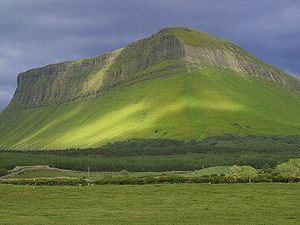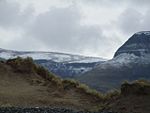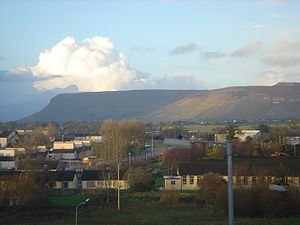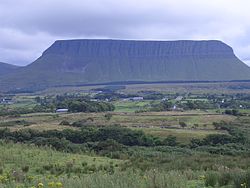Benbulbin
| Benbulbin | |||
| County Sligo | |||
|---|---|---|---|
 Benbulbin's northern side on a cloudy day. | |||
| Range: | Dartry Mountains | ||
| Summit: | 1,726 feet G692463 54°21’52"N, 8°28’29"W | ||
Benbulbin, also written Ben Bulben or Benbulben,[1] is a remarkable mountain of 1,726 feet in the Dartry Mountains in County Sligo. It is in form a vast limestone formation rising almost sheer from its foot, close to the Atlantic coast of the county.
The Dartry Mountains are sometimes called "Yeats Country",[2][3][4] as the inspiration of the poet William Butler Yeats.
Benbulbin is a protected site, designated as a County Geological Site by Sligo County Council.[5]
Name
"Ben Bulben", "Benbulben", and "Benbulbin" are all derived from the Irish name "Binn Ghulbain", which means "peak (or mountain) of the beak (or jaw).[2]
The name is also echoed in the name of the King Conall Gulban, a son of Niall of the Nine Hostages who was associated with the mountain, however, whether he was named after the mountain or the mountain after him is not clear.[2][6]
Geology
Formation

Benbulbin was shaped during the ice age, when Ireland was under glaciers. Originally it was a large plateau. Glaciers moving from the northeast to southwest shaped it into its present distinct formation.[3][7]
Rock composition
Benbulbin, and the Dartry Mountains as a whole, are composed of limestones on top of mudstones. These rocks formed in the area approximately 320 million years ago in a shallow sea. Uppermost in the limestone layer is a thicker, harder limestone called the Dartry Limestone Formation. Below this is a thinner transitional limestone formation – the Glencar Limestone Formation. Further down, the lower slopes consist of shaly mudstone known as the Benbulben Shale Formation. Scree deposits are found near the base.[3][5]
Fossils exist throughout the layers of the mountains. All layers have many fossilised sea shells. The shale layer also holds some corals.[5]
Baryte was mined at Glencarbury near Benbulbin in the Dartry range between 1894 and 1979.[5]

Climbing
Benbulbin is an established walking destination. If climbed by the north face, it is a dangerous climb. That side bears the brunt of the high winds and storms that come in from the Atlantic Ocean. However, if approached by the south side, it is an easy walk, since that side slopes very gently. From the summit there are views over the coastal plain of north Sligo and the Atlantic Ocean.[3]
The land adjacent to the western edge of the ridge is privately owned farmland and not accessible to the general public. However, there is a paved path up the south face to the east near Glencar Waterfall just over the County Leitrim border.
Walking
One of the trails running alongside Benbulben mountain is the Gortarowey looped walk. It runs both through the forest and out in the open overlooking Benbulben and the bay of Donegal. It is two and a half miles in length and would take approximately an hour and a half to walk.[8]
Flora and fauna
Benbulbin hosts a variety of plants, including some organisms found nowhere else in Ireland. Many are Arctic–alpine plants, due to the mountain's height, which allows for cooler temperatures than is normal. These plants were deposited when the glaciers that created Benbulbin melted. Wild hares and foxes inhabit Benbulbin.[3]
In 2012, research revealed that the Fringed Sandwort had survived the Ice Age and is perhaps 100,000 years old. In Ireland the plant is unique to Benbulbin. The discovery calls into question the prior consensus that Ireland's flora and fauna date from or after the end of the Ice Age.[9]
In legend
Benbulbin is the setting of several legends. It is said to be one of the hunting grounds of the Fianna, a band of warriors who are said to have lived in the 3rd century. One example is the story of The Pursuit of Diarmuid and Gráinne,[10] in which the warrior Diarmuid Ua Duibhne (Diarmuid) is tricked by the giant Fionn mac Cumhaill (Finn McCool) into fighting an enchanted boar, which later kills the warrior by piercing his heart with its tusk. The mountain is said to be Diarmuid and Gráinne's resting place.
Also, in the 6th century, St Columba fought a battle on the plain below Benbulbin at Cúl Dreimhne (Cooladrumman) for the right to copy a Psalter he had borrowed from St Finnian.[11]
History

On 20 September 1922, during the Irish Civil War, an Irish Republican Army column, including an armoured car were cornered in Sligo. The car was destroyed by another armoured car belonging to the Irish Free State's National Army, and six of the IRA soldiers fled up the Benbulbin's slopes. In the end, all were killed. (Republican legend insists they were killed after they had surrendered and calls them "the Noble Six".)
-
Benbulbin's northern face
-
The northern face
-
The mountain from the south
-
Benbulbin, with Sligo Bay in the foreground
-
An eastern view
-
A section of the north face of Benbulbin
-
The summit of Benbulbin
-
A snowy Benbulbin, seen from Streedagh Strand
-
Benbulbin from Shannoneighter
During the Second World War there were two aeroplane crashes in the Dartry Mountains close to Benbulbin. On 9 December 1943, a USAAF B-17G Flying Fortress (en route from Goose Bay, Labrador to Prestwick, crashed on Truskmore just east of Benbulbin with ten airmen aboard, of whom three died.[12] Local residents undertook a rescue mission, taking the injured off the mountain where they were then transferred to Sligo County Hospital.
On 21 March 1941, an RAF Catalina flying boat (AM265) using the Donegal Corridor crashed into the mountain at Glenade, Co. Leitrim on the east side of Truskmore. All nine airmen aboard died in the crash.[13]
In literature
Benbulbin features prominently in the poetry of William Butler Yeats, after whom 'Yeats Country' is named. County Sligo is considered integral to the poet's work and Benbulbin is one of the destinations on the Passport Trail of the poet's life.[14]
Yeats wrote the following in The Celtic Twilight:
But for Ben Bulben and Knocknarea,
Many a poor sailor'd be cast away.
The mountain is also mentioned in Yeats's On a Political Prisoner, in which he recalls the Countess Markiewicz riding past it to political meetings.
Yeats's famous poem, Under Ben Bulben, is essentially a description of Yeats Country. It describes:
Under bare Ben Bulben's head
In Drumcliff churchyard Yeats is laid.
An ancestor was rector there
Long years ago, a church stands near,
By the road an ancient cross.
No marble, no conventional phrase;
On limestone quarried near the spot
By his command these words are cut:
"Cast a cold eye
On life, on death.
Horseman, pass by!
This was Yeats's final poem, published in The Irish Times.[15] He is buried in Drumcliffe Churchyard, in the shadow of Benbulbin.
Outside links
| ("Wikimedia Commons" has material about Benbulbin) |
- MountainViews.ie: Benbulbin
- Tourist information
- Climbing Benbulben
- An image of Benbulbin with a small caption
- Information, pictures and a panorama of Benbulbin
- Hiking the Benbulben and the old coal mine
- Sinn Féin Anti British Slogans 1977
Yeats
- An essay on the Benbulbin in Yeats' poetry
- A second site detailing Benbulbin in Yeats' poetry
- Reading of "Under Ben Bulben" by Jim Norton on RTÉ Radio 1
References
- ↑ Benbulbin: Placenames Database of Ireland
- ↑ 2.0 2.1 2.2 MountainViews.ie: Benbulbin
- ↑ 3.0 3.1 3.2 3.3 3.4 Reader's Digest Natural Wonders of the World. The Reader's Digest Association, Inc.. 1988. ISBN 0-89577-087-3.
- ↑ "Yeats Country Drive Sligo". http://www.discoverireland.com/us/ireland-things-to-see-and-do/listings/product/?fid=FI_46826. Retrieved 28 July 2012.
- ↑ 5.0 5.1 5.2 5.3 Williams, Mary Anne (2008). Landscapes, Rocks and Fossils: The Geological Heritage of County Sligo: An Action of the County Sligo Heritage Plan. Sligo Regional Technical College. pp. 21, 22. ISBN 0955565316.
- ↑ McGarry, James: 'Place names in the writings of William Butler Yeats' (Smythe, 1976 ) page 21 ISBN 0901072397
- ↑ "RootsWeb: IRL-SLIGO-L Climbing Benbulben". http://archiver.rootsweb.ancestry.com/th/read/IRL-SLIGO/2000-07/0962914979. Retrieved 2007-04-10.
- ↑ Sligo Walks
- ↑ 'Researchers find first hardy Irish plant that beat Ice Age': Edel O'Connell in the Irish Independent
- ↑ Conner, L.I. (1998). A Yeats Dictionary: Persons and Places in the Poetry of William Butler Yeats. Irish studies. Syracuse University Press. p. 14. ISBN 978-0-8156-2770-8. https://books.google.com/books?id=glhvNnjjNagC&pg=PA14.
- ↑ Bright, Michael (2005). 1001 Natural Wonders You Must See Before You Die. Quintet Publishing Limited. ISBN 0-7641-5817-1.
- ↑ Irish Aviation in World War II –aircraft landings
- ↑ Joe McGowan: The Donegal corridor and the Battle of the Atlantic: History Ireland
- ↑ 'Poetry fans tread softly on trail of Yeats's most beloved haunts': Anita Guidera in the Irish Independent, 29 January 2009
- ↑ 'WB Yeats laid to rest in Drumcliffe': Joe Joyce in The Irish Times, 18 September 1948









